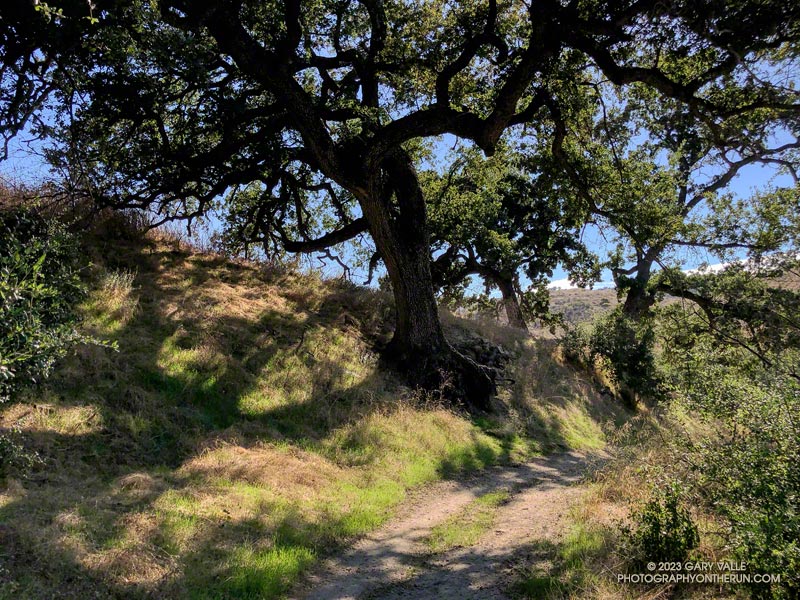
Update September 14, 2023. Mustard is sprouting along Ahmanson’s fire roads, and more surprising — a few mushrooms.
Update September 8, 2023. The new grass from T.S. Hilary’s rain is coming in nicely at Upper Las Virgenes Canyon Open Space Preserve (Ahmanson Ranch).
Tropical storms are a different kind of weather beast than usually seen in Southern California. The warmer air associated with such storms can carry much more water and produce unusually high amounts of precipitation.
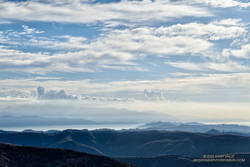
The rain resulting from Tropical Storm Hilary shattered many daily and monthly records. Over decades of record keeping, most stations in the greater Los Angeles area had previously measured only a trace of rain on August 20 or 21, or at best, a few hundredths of an inch. Some stations had never recorded any rain on these days.
This Google Earth image with precipitation data from the California-Nevada River Forecast Center (CNRFC) shows the remarkable rainfall totals across Southern California for the 24-hour period ending at 5:00 a.m. on Monday, August 21, 2023.
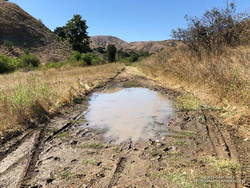
The highest rainfall amounts occurred where the precipitation was enhanced by mountainous terrain. The northeast-facing slopes of the eastern San Gabriel Mountains, near Wrightwood, were ideally positioned in Hilary’s circulation to enhance rainfall. The Big Pine RAWS recorded over 6 inches of rain for the storm, Lewis Ranch slightly over 7 inches, and Lytle Creek nearly 10 inches.
Detailed observation and impact reports for Hilary are available from NWS Los Angeles/Oxnard, NWS San Diego and the Center for Western Weather and Water Extremes.
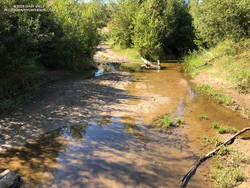
Curious to see some of the local impacts of the storm, I ran at Ahmanson Ranch on August 22 and then a few days later at Malibu Creek State Park.
My West Hills weather station, about three miles from Ahmanson Ranch’s Victory Trailhead, recorded 3.86 inches of rain for the storm. After an initial technical hiccup, the Cheeseboro RAWS, overlooking Las Virgenes Canyon, recorded 3.52 inches of rain. This and other data suggest rainfall amounts in the Ahmanson area of at least 3.5 – 4.5 inches.
My Ahmanson run started at the Victory trailhead, went out East Las Virgenes Canyon, through part of Las Virgenes Canyon, and then up to Lasky Mesa. With that much rain, I was sure I would be wallowing in the mud and wading the creek crossings. But my shoes didn’t even get muddy!
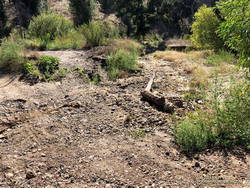
There was certainly some mud, puddles, and a little erosion, but the impact of Hilary on Ahmanson was surprisingly minor. The ground must have been desiccated because Las Virgenes Creek had almost no increase in flow. The creek crossings near the pipeline station and south of the station were essentially the same as before Hilary. Even more surprising, there was no water at the crossing a little north of the Las Virgenes Trailhead.
As Hilary moved northward in California, the counterclockwise circulation of the storm increased the rainfall in the Santa Monica Mountains. Automated RAWS stations in Topanga, the Malibu Hills, and in Malibu Canyon recorded 4.0 to 4.5 inches of rain during the storm. CNRFC gridded precipitation data indicated higher amounts in some parts of the range.
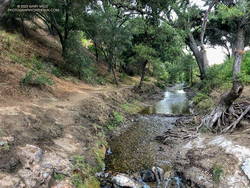
On August 27, I ran the Bulldog Loop in Malibu Creek State Park. The run started at a small parking area at the junction of Malibu Canyon & Piuma Roads. As I was running up the Tapia Spur Trail, I wondered if State Parks had — as a precaution — removed the seasonal bridge across Malibu Creek on the Crags Road Trail. On August 19, the day before Hilary drenched the area, the bridge had been in place for the Bulldog Ultra. If it wasn’t removed, did Malibu Creek get high enough to damage it?
Once again, I need not have worried. The bridge was just fine, and the reeds in the water near the bridge suggested only a modest increase in streamflow.
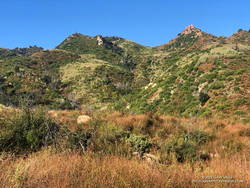
It looked like Malibu Creek State Park received more rain than Ahmanson Ranch. There was slightly more erosion on the dirt roads and some small sluffs/slides, including one tree that slid onto Mesa Peak Mtwy fire road. A tree had also fallen near the beginning of the Forest Trail.
Back at Ahmanson on August 31, things were drying out, but it was beginning to look like Spring. Grass was sprouting all over Ahmanson Ranch. It will be interesting to see if the grass survives the inevitable heat and grows enough to turn the hills green. The little bit of rain and cooler weather over Labor Day weekend will help. Some out-of-season wildflowers could also result from a false Spring.
Yesterday, I did a run in Topanga State Park, and the story was much the same. There was some minor erosion on the fire roads, but none of the larger sluffs and slides seen during the rainy season. There was no new damage to the Musch or Garapito Trails. It did look like the flow had increased on Garapito Creek with Hilary’s rain, and there was a still little water in the mainstem of the creek.
